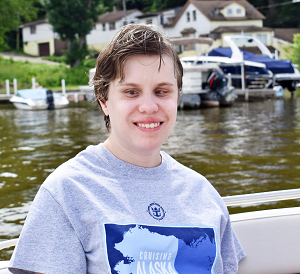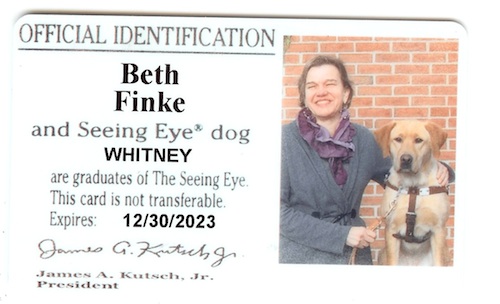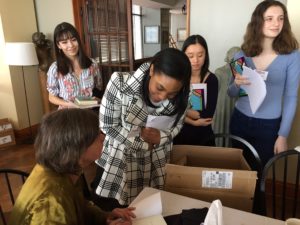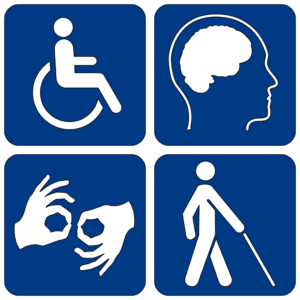Mondays with Mike: When smoke gets in your eyes
August 26, 2019 • 2 Comments • Posted in Mike Knezovich, Mondays with Mike, travelWell, I made it back from a week in Alaska in one piece. A little sore, but I had no bear encounters, no ankle sprains, just some stiff joints. (I did see a moose.)

This was a typical, smoke-hazy, morning view.
Where to start about Alaska? I saw some tiny bit of it but even the tiny bit of it seemed endless—mountains, glaciers, fast-moving pristine streams, repeat, repeat, repeat.
Unfortunately, I saw a lot of smoke as well.
When I landed in Anchorage two Saturdays ago, I met my fellow traveler Kevin; we hopped in a rental, and headed for our cabin in Cooper Landing, Alaska. It was a lovely drive around an ocean inlet that was couched by mountains. But as we got closer, the view grew hazier, and by the time we reached our little log home, the entire inside smelled like a fireplace. It was bad enough that, in the pristine wilds of Alaska, we had to close the windows.

Saw only one moose.
It didn’t get better overnight. We packed our stuff, intent on staying away for the day and returning at night just to sleep. Our hike that day took us to Portage Glacier, far enough away that the smoke wasn’t a problem. (Though everywhere was hazier than normal.) Kevin used his phone to monitor the fire reports—it was looking worse by the hour. Our cabin was in an area that was deemed “be prepared to evacuate” and roads were being closed.
So, after some discussion, the two of us decided we should try to find other lodging away from the fire, and get our stuff while we could still get it. As it turns out, when we approached the turnoff to our place, the road there had already been closed by authorities. We explained to the officer exactly where our cabin was and that we’d be leaving right away. He let us through. We got our stuff and headed to Seward, Alaska. Unfortunately, there were no rooms at the inns—we ended up staying in divey rooms above a seafood restaurant. The hallway smelled like fish, not smoke, but luckily the rooms did not.
The next day we awoke to…more haze from the fires. We spent the morning inside the The Alaska Sea Life Center in Seward—highly recommended destination. And then we took a chance and drove to Exit Glacier. We lucked out—it was, relatively speaking, clear, and we took a manageable hike to check it out.
Afterward, we managed to get rooms at a nearby Best Western, which, after the previous night’s experience, felt like the Ritz Carlton.
The next day we took the Harding Ice Field Trail along the Exit Glacier in Kenai Fjords National Park. Kevin, a veteran hiker, made it all the way to the top—a 3,800 ft ascent over just under five miles. I only made it a little over half way. Deciding discretion was the better part of valor, I turned around. While I would’ve liked to see the otherworldly expanse of ice that Kevin described, I was content with my lot. By the time I descended, my legs told me I’d made the right call.
So no, I didn’t see the ice fields, but it was spectacular nonetheless.

A stop along the Harding Ice Flow trail.
The glacial ice was blue—it’s compressed so densely from its own weight that it absorbs the entire spectrum of light except blue. The meadows along the way weren’t bad either.
Later, Kevin drove us four hours to our next stop in Glacier View. Well, yes, our cabin overlooked the Matanuska Glacier. But, again, beyond the glacier, the mountains were obscured by haze.
While the Amazon burns, so does Alaska.
The wildfires in Alaska are not a headline story—yet – but the temperatures this summer have set records, and the place is dry.
Over our three nights there we managed to take a couple leisurely hikes, eat some really good fish, and…visit the Alaska State Fair, a subject worthy of its own post some day.
I wouldn’t trade my time in Alaska for anything. But the smoke was a reminder—we’re in trouble folks. Anecdotally, the owner of our first cabin said he’d been there thirty years and he’d never seen a summer like this one. The fire near that cabin wasn’t the only one. The McKinley fire, still burning, had closed the road to Denali temporarily.
As I’ve told this story to friends, most were unaware of fires in Alaska. That’s largely because of…fires in the Amazon and elsewhere. Including the Arctic—yes—fires in the Arctic. (This story is worth the time.)
There are discussions to be had—and reasonable differences to be hashed out—about what best to do about man-made climate change. Cap and trade? How best to curb admissions, promoting renewables, what to do in the face of current and future effects. Because they’re coming.
But it all starts with acknowledging we have a problem of our own making.




